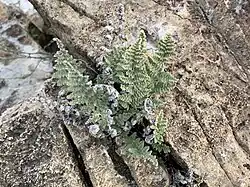Myriopteris windhamii
| Myriopteris windhamii | |
|---|---|

| |
| Scientific classification | |
| Kingdom: | Plantae |
| Clade: | Tracheophytes |
| Division: | Polypodiophyta |
| Class: | Polypodiopsida |
| Order: | Polypodiales |
| Family: | Pteridaceae |
| Genus: | Myriopteris |
| Species: | M. windhamii
|
| Binomial name | |
| Myriopteris windhamii Grusz
| |
| Synonyms | |
| |
Myriopteris windhamii, formerly known as Cheilanthes villosa,[2] is a species of lip fern, with the common name villous lipfern. It is native to the southwestern United States[3] and Mexico.
Description
Myriopteris windhamii is a medium-sized tufted fern growing from a short rhizome with bicolored scales. Leaves are up to 20–30 cm (7.9–11.8 in) long. The leaf blades are mostly lanceolate, 3- or 4-times divided, and green to grayish on top, with bead-like ultimate leaf segments. The abaxial (lower) leaf surface is densely covered with whitish hairs, which often also envelop and entangle hairs on the adaxial (upper) surface. Scales on the costae are not ciliate or rarely with one or a few cilia.[4]
Myriopteris windhamii is similar in appearance to Myriopteris lindheimeri but can be distinguished by bicolored rhizome scales, costal scales not markedly ciliate, and hairs attached directly to the adaxial (upper) leaf segments (not just growing over the upper leaf surface as in Myriopteris lindheimeri).[4]
Range and Habitat
Myriopteris windhamii is native to the southwestern United States where it grows in rocky mountains and deserts. For example, it is found along with the elephant tree, Bursera microphylla, and other desert species in the Waterman Mountains of southeastern Arizona (northern Pima County).[5] It is often found on limestone or other calcium-rich rocks and soils.[4]
Taxonomy
Members of the genus Cheilanthes as historically defined (which includes Myriopteris) are commonly known as "lip ferns" due to the lip-like (false) indusium formed by the leaf margins curling over the sori.[6] It is commonly known as villous lip fern.[7][8][9]
Myriopteris windhamii is an apogamous (asexual) triploid of unknown parentage.[4]
Cultivation
Myriopteris windhamii can be relatively easily cultivated, and should be grown under high light in well-drained garden soil. The soil should be basic and moist-dry to moist.[9]
References
- ^ NatureServe (November 1, 2024). "Cheilanthes villosa". NatureServe Explorer. Arlington, Virginia. Retrieved November 17, 2024.
- ^ Grusz & Windham 2013.
- ^ USDA Plants Profile. 2009
- ^ a b c d Felger, R.S., S. Rutman, J. Malusa, and T.R. Van Devender. 2013. Ajo Peak to Tinajas Altas: A flora of southwestern Arizona: Part 3: Ferns, lycopods, and gymnosperms. Phytoneuron 2013-37: 1–46.| url=https://cals.arizona.edu/herbarium/sites/cals.arizona.edu.herbarium/files/pdf/03PhytoN.pdf
- ^ C. Michael Hogan. 2009. Elephant Tree: Bursera microphylla, GlobalTwitcher.com, ed. N. Stromberg
- ^ Clute 1901, pp. 237, 242.
- ^ Windham & Rabe 1993.
- ^ Lellinger 1985, p. 147.
- ^ a b Hoshizaki & Moran 2001, p. 238.
Works cited
- Clute, Willard N. (1901). Our Ferns in Their Haunts. New York: Frederick A. Stokes Co.
- Grusz, Amanda L.; Windham, Michael D. (2013). "Toward a monophyletic Cheilanthes: The resurrection and recircumscription of Myriopteris (Pteridaceae)". PhytoKeys (32): 49–64. doi:10.3897/phytokeys.32.6733. PMC 3881352. PMID 24399906.
- Hoshizaki, Barbara Joe; Moran, Robbin C. (2001). Fern Grower's Manual. Portland, Oregon: Timber Press. ISBN 9780881924954.
- Lellinger, David B. (1985). A Field Manual of the Ferns & Fern-Allies of the United States & Canada. Washington, DC: Smithsonian Institution Press. ISBN 0-87474-603-5.
- Windham, Michael D.; Rabe, Eric W. (1993). "Cheilanthes villosa". In Flora of North America Editorial Committee (ed.). Flora of North America North of Mexico. Vol. 2: Pteridophytes and Gymnosperms. New York and Oxford: Oxford University Press. Retrieved July 22, 2025.
